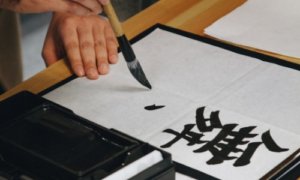Hi! If you’re seeing this, you’ve probably purchased my Japanese Pronunciation Trainer (if not, you can get it at the store). I’m going to be using this page to keep track of changes, to provide instructions for repairing problems, and to have a central place to keep the instructional videos that you should watch before using your pronunciation trainer.
ESSENTIAL VIDEOS TO START LEARNING
– Instructions for using your pronunciation trainer effectively
– Japanese Video 1: The Japanese Writing Systems (and Pitch Accent)
– Japanese Video 2: Japanese Consonants
– Japanese Video 3: Japanese Vowels
– Japanese Video 4: Some Quirks of the Kana Spelling Systems
HOW TO USE ANKI
– How to use Anki for the first time
– Creating an AnkiWeb account
– Getting Anki synchronized across your various devices
– I’m having trouble installing Anki or the deck, where can I get help?
MODIFYING YOUR DECK
– Optional spelling test version
LANGUAGE LEARNING RESOURCES
– Other useful pronunciation resources specifically for learning Japanese
– Fluent Forever Help Center
And for additional Japanese language learning resources to help you on your journey to fluency, check out our comprehensive free-to-use list right here.
FLUENT FOREVER PRONUNCIATION TRAINER VS FLUENT FOREVER APP
– Are the Fluent Forever Pronunciation Trainers the same as the Fluent Forever App?
– I heard you have an app in development, but I just bought your other materials. What do I do?
Want to get the Fluent Forever App? You can still help Fluent Forever create the first app that can bring you all the way to fluency — find Fluent Forever on Indiegogo.
NEXT STAGE OF THE FLUENT FOREVER METHOD
– I’ve completed the pronunciation trainer, what do I do next?
UPDATES TO THE PRONUNCIATION TRAINER
– Pronunciation trainer versions changes
– Bug reports to be reviewed
– Get the latest version
ESSENTIAL VIDEOS TO START LEARNING
Instructions for using your pronunciation trainer effectively:
Japanese Video 1: The Japanese Writing Systems (and Pitch Accent)
Japanese Video 2: Japanese Consonsants
Japanese Video 3: Japanese Vowels
Japanese Video 4: Some Quirks of the Kana Spelling Systems
Note: If you’d like more information on phonetics and the IPA, check out this series of videos. I’ve also create the International Phonetic Alphabet (IPA) Anki deck, which is available at the Fluent Forever shop.
HOW TO USE ANKI
How to use Anki for the first time
First, you’ll need to install Anki onto your computer if you haven’t already. The details of how to install Anki is provided in the ReadMe file you received with your Pronunciation Trainer. Once you have followed these instructions and installed Anki, you’re free to start studying using the pronunciation trainer deck.
If you have more questions about Anki and learning Japanese, there’s also the Anki language learners community on Reddit. You can even check out this Anki language learning blog for other Anki tips and tricks for learning Japanese.
If you’ve never dealt with Anki before, we’ve created Anki video tutorials to help guide you when using Anki for the first time. You will find tutorials about:
- Getting Anki installed and making your first flashcards
- Installing the Model Deck
- Learning Simple Spellings and Sounds with the Model Deck
- Learning Simple Words with the Model Deck
- Creating Flashcards with images and sound files
Go to our How to use Anki page to access the tutorials.
Creating an AnkiWeb account
Create a free AnkiWeb account to regularly and automatically save your Anki data online by syncing your computer’s Anki account with an AnkiWeb account.
This is useful if you lose all your Anki files on your computer and want to download the latest version of your Anki decks and cards. Having an AnkiWeb account means you can also study your Anki deck and cards on several devices, such as your computer, smartphone and tablet, and you can easily move your decks and cards to different devices.
Learn how to create an AnkiWeb account for free here.
Getting Anki synchronized across your various devices (Laptops, smartphones, etc.)
I’m having trouble installing Anki or the deck, where can I get help?
If you are having difficulties installing Anki or the deck, please check out the Fluent Forever Help Center as your question may already be answered there.
If you can’t find the answer at the Fluent Forever Help Center, you can either post the problem on the forum or send us an email. Please include as much detail as possible and screenshots of the issue.
MODIFYING YOUR DECK
Optional spelling test version
This is an optional version of the deck that asks you to actually type in words to test your spelling, rather than just spelling out the words in your head.
I’ve included a pre-made version of this called the “Optional Spelling Test Version” in the pronunciation trainer download. If you would like to have this feature in your deck, please follow the instructions in your ReadMe file.
LANGUAGE LEARNING RESOURCES
Other useful resources specifically for learning Japanese
We have a dedicated page of other Japanese language learning resources you can tap into. These are books, websites, and tools that I personally recommend using.
There is also a general language learning resources page on our website that provides a list of tools and resources that may also be useful for you.
There are also some useful Anki flashcards for Japanese to improve your pronunciation, such as the Japanese alphabet, IPA pronunciation and other useful goodies.
You can even access ready-made Japanese Anki decks to boost up your Japanese vocabulary which is recommended, as it could save you time and get you started faster.
Fluent Forever Help Center
The Fluent Forever help center provides you with advice and answers from the Fluent Forever Team about the most common questions users have. You can access articles about:
- Kickstarter and Indiegogo: Frequently Asked Questions
- Ordering from the Fluent Forever Shop
- The Fluent Forever Pronunciation Trainers
- The Fluent Forever Word Lists
- Learning Grammar
- Language Learning in General
- Language Specific Support
- Anki Troubleshooting and Custom Decks
FLUENT FOREVER PRONUNCIATION TRAINER VS FLUENT FOREVER APP
Are the Fluent Forever Pronunciation Trainers the same as the Fluent Forever App?
Nope, they’re different!
The Fluent Forever Pronunciation Trainers are a set of videos and audio-visual flashcards. To use them, you watch some videos on YouTube, then you download a flashcard app called Anki, load our pronunciation trainer flashcards into Anki, and start studying. After 2-3 weeks, you’ll have a solid foundation in the sound system of your target language, both in terms of ear training and in terms of the spelling system. After that, you can go create flashcards on your own within Anki, as described within the Fluent Forever book. We began creating these trainers in 2013, and finished in late 2017.
The Fluent Forever App is a much bigger project that we’re currently working on. Many of our users have had trouble learning how to use Anki, or have found that parts of the flashcard creation process were overly tedious. Instead of spending all of their time exploring their new language, they were getting stuck, spending their time struggling with flashcard creation.
In response, we decided to make our own mobile app that could automate the entire Fluent Forever method, so that a student could focus all of their time on exploring their target language, while the app created flashcards automatically, based upon that student’s choices. While the Fluent Forever App DOES teach pronunciation in the first few weeks, that’s only a small part of what it can do. It’s designed to take you all the way to fluency, teaching you vocabulary and grammar from 1,875 sentences we’re making, and letting every user of the app share their original content with every other user of the app. Within the next year or two, this will become the largest database of easily learnable sentences in the world. We began this project in late 2017, and we should have a final version ready by August of 2018. If you’d like to get early, discounted access, join our Indiegogo campaign: http://indiegogo.fluent-forever.com
I heard you have an app in development, but I just bought your other materials. What do I do?
Want to get the Fluent Forever App? You can still help Fluent Forever create the first app that can bring you all the way to fluency — find Fluent Forever on Indiegogo.
NEXT STAGE OF THE FLUENT FOREVER METHOD
I’ve completed the pronunciation trainer, what do I do next?
If you have completed the pronunciation trainer deck you will no longer see any daily cards to review in Anki. If you’re still having problems with pronunciation, you could ask for help at the Reddit Forum for Anki
Language Learning or try Rhinospike.com for help. There are also other websites that have pre-made flashcard deck resources which are highly recommended, such as the alphabet flashcards, IPA pronunciation flashcards and other useful goodies. There’s also blogs about language learning tips with Anki in general which could help you.
The next step in becoming fluent in Japanese is to learn a set of extremely common, simple words using pictures, not translations. There are 625 basics words that are commonly used. You can purchase the Wordlist for Japanese at the shop and begin creating cards to study.
There’s also the option of using ready-made decks of Japanese vocabulary, or checking out a Japanese frequency dictionary.
You can read more about this stage of the Fluent Forever method in Chapter 4 of the Fluent Forever Book entitled “Word Play and the Symphony of a Word”. If you don’t already have the book, you can purchase the audiobook version at our shop or purchase a physical copy online.
UPDATES TO THE PRONUNCIATION TRAINER
Pronunciation trainer versions changes
The following are the various versions of the Pronunciation Trainer, listed from the newest to oldest, along with information on new features and improvements in each version.
Version 3.0
On June 12, 2018, the Fluent Forever Japanese Pronunciation Trainer Version 3.0 was released to the public.
What’s New
General
- Upgraded the version number to 3.0, as part of a major concurrent update for all Pronunciation Trainers in order:
- To phase out all Beta releases and move all Trainers into non-Beta
- To make all Trainers uniform by placing them within the 3.0 version series (even for Trainers without a Version 2.0)
- To make it easier for version control in the future
- Updated the names of the folders, zip file and other files of the Pronunciation Trainer so that they are all standardized, easier to understand and follow the same conventions as all other Pronunciation Trainers in the 3.0 version series
- Updated the URLs and titles of the Pronunciation Trainer Resources page so that they are all standardized, easier to understand, and follow the same conventions as all other Pronunciation Trainers in the 3.0 version series
- Added a new hidden, suspended note in the Pronunciation Trainer Anki deck which includes basic information about the current version number of that particular deck. This will make it faster for users to get Fluent Forever tech support for their specific version
- Improved the documentation and accessibility of version release notes and bug reports with updates
Word Stress Cards
- Added new “Word Stress” cards for languages with word stress rules. Those languages included: Spanish LA, Spanish EU, Dutch, Hebrew, Hungarian, Italian, Japanese, Portuguese
What’s the Meaning of Words Cards
- Deprecated: “What’s the word?” and “What’s the word mean?” card types
- Modified the “Picture Words” card model so that it doesn’t force students to try and memorize words, but rather just spell them or pronounce them out loud.
- Created distinct Trainer versions for “Old Users” and “New Users”. Old Users are those who have already installed and used the Trainer in the past, and would like to update their Trainer. New Users have never installed and used the Trainer before. Users must use their respective Trainer version so that the “Picture Words” cards display properly.
ReadMe File
- Changed the filetype from HTML to PDF
- Updated the design of the ReadMe file, such as the color scheme and formatting, to improve user experience
- Improved the explanations of each of the ReadMe file steps to make them easier to understand
- Included screenshots of the main steps to make the ReadMe file more user-friendly
- Added a FAQ section with useful answers, such as suggestions for what to do after finishing the Trainer, and the difference between the Pronunciation Trainer and the Fluent Forever App
- Removal of references in the ReadMe file to the Beta version of the Trainer
- Included link to the Fluent Forever App as a faster alternative to the Trainer
Bug Fixes
- Cards 14.1, 14.5, 15: Changed IPA from “doːd͡ʑibo↓ːɽu͍” to “dod͡ʑːibo↓ːɽu͍”
- Added new minimal pair cards with Sort Order 208 and 210: Minimal pair includes the words: “糸 [いと] [ito] string” and “井戸 [いど] [ido] well (as in water well)
- Cards 4.35, 4.7, 6.9: Changed IPA from “ke↓ːbu͍ɽu͍kaa” to “keːbu͍ɽu͍↓kaː”
- Cards 10.25, 10.55, 11.75: Change the word from “スポーツウエア” to “スポーツウェア”
Responses to Previous Bug Reports
Other bug reports may have been given about the previous version of this Trainer, and all of them were checked and considered. To see a full list of the bug reports that were checked, including details of whether those bugs were fixed or not fixed for the latest version of the Trainer, please see this Trainer’s: Bug Reports for “All Versions Prior to Version 3.0
All versions prior to Version 3.0
Bug Fixes & Bug Reports
- For spelling rules, the card with the sort order 23.95. It’s asking to spell the word for lion (in hiragana). When it reveals the answer, the answer is in katakana. Got it.
- Minimal pairs 171 and 173. The English word “ski” isn’t recorded properly. Sounds more like “sgi” making the minimal pair test far too easy. I’ll keep this one in the to-do list until I get a chance to re-record with another bilingual. Her “ski” is technically correct (after “s”, [k] in English is unaspirated and sounds a lot like [g]), and yet it’s still kind of weird sounding in terms of the timing.
- In the Japanese pairs package, there are some cards where it is impossible to know the right answer, because both answers look identical when written in hiragana. For example, one card has 2 words both pronounced ‘すき’ with no other orthography given. It should show you the IPA underneath…let us know if it doesn’t.
- I believe the drawing for the FTSE card is incorrect. Shi is drawn instead of tsu. Fixed
- Why the イ is pronounced as j(a)? This sounds strange! Can’t find this!
- In Japanese v1.04.apkg, I notice that the “Good” time is two minutes, which is much less than the “Again” time of 8 minutes. See http://imgur.com/AS1WFYi, for example. My other Anki decks have a shorter repetition time for “Again” than for “Good.” The ‘good’ time is actually 8 minutes, then 6 minutes, then 2, then 2 for first-time minimal pairs. It does that so that you’re likely to see new minimal pairs and get exposed to them before you start reviewing the old ones, but after that happens and you’ve gotten them correct a couple of times, then you start seeing them more often, so you’re likelier to test them back-to-back or nearly back-to-back with other pairs.
- I think there might be an error on one of the minimal pairs. The card asks you distinguish if you heard “ひよう” or “ひょう”. However, the recording for “ひょう” to me sounds more like “しょう” (with a clear “sh” sound). The recordings are accurate, to my ear. What I think is going on is that the lip rounding and the raising of the back of the tongue (to prepare for the う) are creating so much restriction in the airflow that it’s sounding a lot like しょう (which makes me think that ひょう & しょう would make a really interesting pair.
Japanese Beta v1.01:
- Fixed some spelling issues (mostly Katakana words that were written in Hiragana) in minimal pairs 28,32,50,54,58,62,57,61,99,103,105,109,115,119,155,159,37,40,144. Replaced some of the picture words: 1813,2011,2026,2151,2251,2255.
Japanese Beta v1.02:
- On the “Tsar” card, the drawing order is wrong (shi not tsu) [FIXED]
- In the minimal pair deck (beta 2), びん/bean: the Japanese [bʲi] is too long [FIXED], and for たい/tie I hear, most of the time (but not always), かい/kye instead. [LEAVING THIS AS IS]
- The pronunciation of ク has none of the vowel sound (only the sound of breath), but the pronunciation of キ does include the vowel sound. [LEAVING AS IS]
- Use Sukiunvoiced2 [FIXED]
- Replace suitcase IPA with “su” [FIXED]
- タバコ shouldnt be in hiragana [FIXED]
Recent Bug Reports (as of October 2015):
- The sound card for “pollution” (“公害”), seems to be wrong. FIXED
- The image showing the stroke order for the word, “jogging,” seems to be wrong. FIXED
- In beta 1.02, card 5.3 FIXED
- パ (pa) sounds like タ(ta).
- In beta 1.02, card 5.3 FIXED
- Sound should be パ (pa), but seems to be タ(ta) instead.
Bug reports to be reviewed
If you encounter problems with your trainer: Please check that you are using the latest version of the Pronunciation Trainer before reporting any bugs.
If you encounter problems and are using the latest version: Either email it over or post it to the forum. Include screenshots if possible (if you need an image upload service, use Imgur.com), and be as detailed as you can! If the forum won’t cooperate or if you have something you’d prefer to send in private, send an email.
Please read through the bug report to check whether the bug has already been reported before sending an email or posting on the forum.
Get the latest version
If you have previously purchased the Pronunciation Trainer, you should have received an email regarding the release of the latest version and the direct link to download the latest version. If you did not receive the latest version, please send us an email.
If you do not have the Pronunciation Trainer, you can purchase it here: https://fluent-forever.com/product/fluent-forever-pronunciation-trainer/




